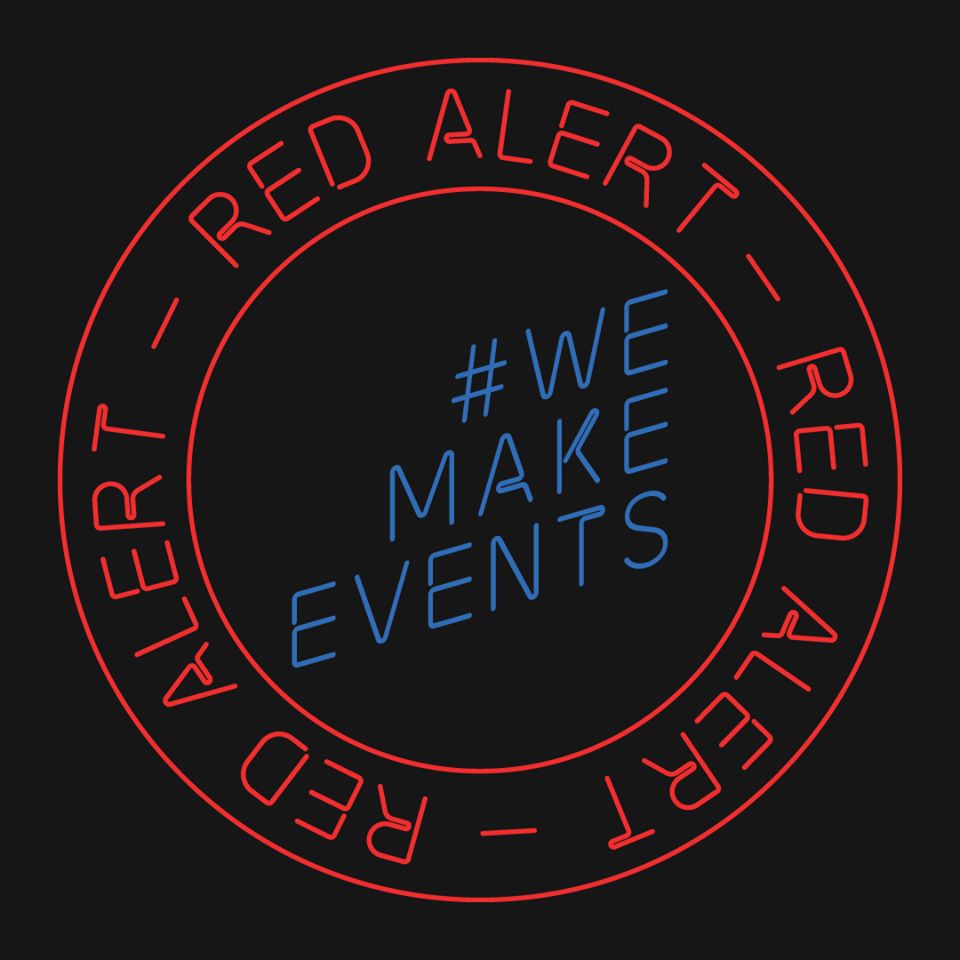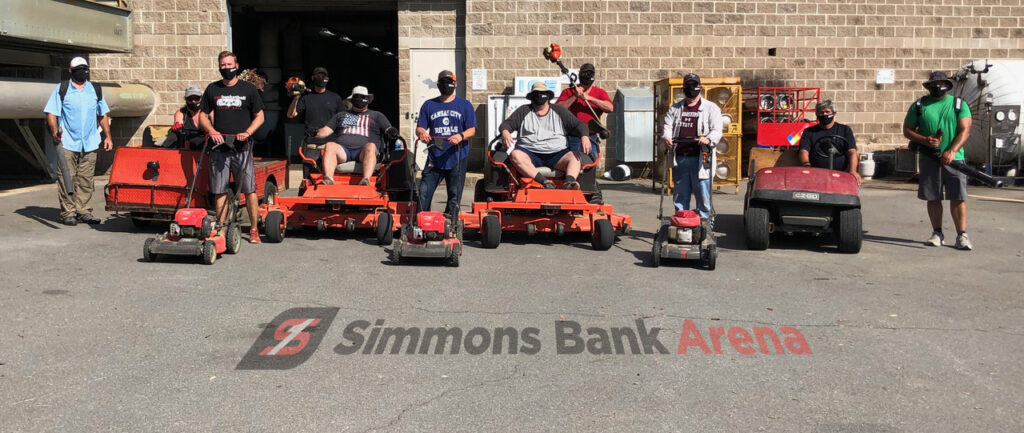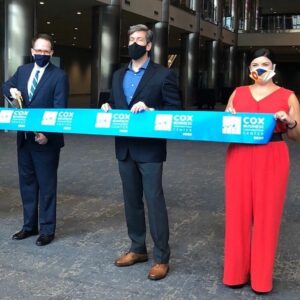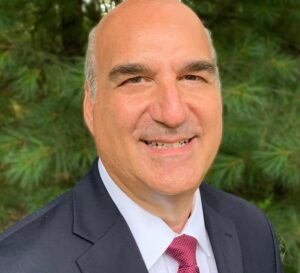#WeMakeEvents #RedAlertRESTART to Light 1,500 Buildings in Red on Tuesday, September 1
By Ellen Lampert-Greaux
#WeMakeEvents #RedAlertRESTART and #ExtendPUA represent a major call to action, imploring the US Congress to pass the RESTART Act (S.3814) as quickly as possible, offering economic relief to the Live Events Industry, which has been shuttered since March 2020, putting millions of people out of work. Additionally, the movement is to support ExtendPUA.org in their efforts towards continuation and extension of the Pandemic Unemployment Act to provide relief to those without work due to COVID-19.
To call attention to the deep financial plight of the Live Event Industry, a nationwide event will take place on Tuesday, September 1, 2020, from 9 pm-12 midnight, when as many as 1,500 buildings across North America will be lit in red. The goal to raise public awareness that the Live Events Industry is on Red Alert for its very survival, and create congressional pressure to act now. It is estimated that 96%, or as many as 12 million people in the Live Events Industry are currently unemployed, furloughed, or have lost up to 90% of their income, and the world’s largest concert promoters are reported a 98% loss of revenue since the start of the pandemic. Once a robust $35 billion industry, the Live Events business was the first to close and the last to re-open, sustaining increased financial losses in the tens of billions of dollars.
Tuesday, September 1, 2020, from 9 pm-12 midnight, when as many as 1,500 buildings across North America will be lit in red. The goal to raise public awareness that the Live Events Industry is on Red Alert for its very survival, and create congressional pressure to act now. It is estimated that 96%, or as many as 12 million people in the Live Events Industry are currently unemployed, furloughed, or have lost up to 90% of their income, and the world’s largest concert promoters are reported a 98% loss of revenue since the start of the pandemic. Once a robust $35 billion industry, the Live Events business was the first to close and the last to re-open, sustaining increased financial losses in the tens of billions of dollars.
The targeted list of cities for the #WeMakeEvents #RedAlertRESTART #ExtendPUA event on August 27 across North America includes Washington D.C., Huntsville, Los Angeles, San Francisco, Denver, Orlando, Tampa, Miami, Atlanta, Chicago, New Orleans, Boston, Baltimore, Las Vegas, New York City, Philadelphia, Pittsburg, Nashville, Dallas, Austin, Houston, Salt Lake City, Seattle, Portland, Phoenix, and Canadian neighbors including Toronto, Montreal, and Vancouver.
The North American event comes on the heels of the August 11 event #WeMakeEvents Red Alert Day Of Action when over 700 buildings were lit in red across the UK, calling attention to the same plight facing the Live Events Industry there.
As theatres, concert tours, festivals, opera houses, trade shows, and other live events as well as film and television production remain closed, or open on a very limited basis, the entire industry is impacted, from designers, technicians, programmers, and stagehands to rental shops, manufacturers, and distributors of entertainment technology. The first industry to close last March, Live Events could be the last sector to re-open due to the COVID-19 crisis.
“This is an important cause that, if not acted upon immediately, could result in the complete collapse of our industry and the workers who make it possible,” says Brad Nelms, director of #We Make Events North America. “The results from the UK efforts were outstanding. We’re hoping that we can generate at least double the participation to demonstrate how much impact this shutdown has had and will continue to have. PLEASE share this message far and wide, and join in by lighting your house red and posting it on social media. This is our opportunity to show the world the scale of what it really takes to make events possible.”
For information about joining the event and lighting your building red, please contact:
WeMakeEventsNorthAmerica@gmail.com
Ellen Lampert-Gréaux is PR director for #WeMake Events North America
Certification Board Accepting CVE Applications Beginning September 1
By R.V. Baugus
While COVID-19 has played havoc with all kinds of scheduling and events, the IAVM Certification Board announced that CVE applications will be accepted beginning on September 1 with a due date of November 1.
“COVID-19 has impacted everything, and the Certification Board is trying to be flexible to ensure our programs are accessible to all certification candidates during these challenging times,” said Rick Haycock, CVE, Chair of the Certification Board. “Whereas the certification exams have typically been staged during live IAVM events, testing can now be accommodated using local services, such as with a venue’s HR director or legal counsel, a testing center or other professional services. Similarly, for the first time, this year we will conduct all CVE Oral Interviews remotely (via Zoom). With these adaptations, certification candidates will be able to continue their certification journey unabated during this crisis.”
Meanwhile, CVP applications are still being accepted as they always are on a “rolling” basis all year. The application can be emailed once completed and can be found here.
Once an application has been received and approved by the Certification Board, a candidate may start the process of scheduling the exam.
Historically the exam has been given at IAVM events and with special permission through local testing centers. Due to current limited travel and in-person events, candidates are able to use a local CVE (IAVM Headquarters can provide a list for the candidate to reach out to) or their HR Director. Proctors must still be approved, but the goal is to provide more flexibility to allow more testing.
Since the CVP exam has been digital, this remains the same test that would have been given at an IAVM events. No special software is needed, only internet access.
Mow-Mentum! Michael Marion & Simmons Bank Arena Team on “Cutting” Edge
After #COVID19 forced the Simmons Bank Arena in North Little Rock, Arkansas, to furlough 13 of its staff including operations, the venue’s full-time administrative staff stepped up and is participating in #MowMonday!
From left behind the masks:
Jared Lillard – Director of Finance
Sandra Stewart – IT Coordinator
Jeremy Flynn – Sales Manager
John Gillis – Director of F&B
John Dippel – Director of Ticketing
Madison Saulsbury – Senior Accountant
Joe DeGeorge – Director of Event Services
Wesley Holmes – Assistant GM
Michael Marion – GM
Ronnie Aultman – Operations Manager
Shay Matyja – Security Manager
Grand Re-Opening and Ribbon Cutting Held for Tulsa’s Cox Business Convention Center
By Holly Beal
After a two-year Vision Tulsa renovation, Cox Business Convention Center (CBCC) hosted a ribbon cutting ceremony celebrating the grand re-opening of the venue’s east side with city partners, staff, guests, clients, and leadership in attendance. The event included the following speakers during the program: CBCC Assistant General Manager, Angie Teel, CMP, City of Tulsa Mayor G.T. Bynum, Tulsa Public Facilities Authority (TPFA) Chair Marcia MacLeod, President & CEO of T.D. Williamson and Tulsa Regional Tourism Executive Board member Bob McGrew, and Cox Communications Vice-President and Tulsa Market Leader and Tulsa Regional Chamber Board of Directors Chair Roger Ramseyer.
The 2018-2020 renovation complements the existing convention center constructed in 1962, and the renovation of  the venue’s northwest side as part of Vision 2025. The building’s unique architectural design is preserved and even highlighted by the new three-story glass atrium entrance and the creation of CBCC’s official “front door.” A renovated South Plaza and valet and ride share drop-off area have already been completed outside (with a public art install still to come), and inside there’s a new security and staff entrance area and over 8,000 square foot of natural-light filled space in Grand Gallery. The former 9,000-seat arena was converted into Grand Hall – a 41,470 square foot multi-use event space with 36” waving wood ceilings. The project also includes a new kitchen, box office, restrooms, sensory room, and escalators.
the venue’s northwest side as part of Vision 2025. The building’s unique architectural design is preserved and even highlighted by the new three-story glass atrium entrance and the creation of CBCC’s official “front door.” A renovated South Plaza and valet and ride share drop-off area have already been completed outside (with a public art install still to come), and inside there’s a new security and staff entrance area and over 8,000 square foot of natural-light filled space in Grand Gallery. The former 9,000-seat arena was converted into Grand Hall – a 41,470 square foot multi-use event space with 36” waving wood ceilings. The project also includes a new kitchen, box office, restrooms, sensory room, and escalators.
“Thank you, Tulsa voters, for supporting this improvement to Cox Business Convention Center,” said Mayor G.T. Bynum. “This Vision Tulsa renovation brings our 20th century convention center into the 21st century, with updated design and functionality. This improved and expanded facility will help Tulsa attract top quality events and conventions to our world-class city.”
The $55 million project was funded by Vision Tulsa with a development team including MATRIX Architects Engineers Planners, Inc., Forest for the Trees, and Tulsa Vision Builders.
“I am grateful for the support Tulsa votes have given to important Vision Tulsa projects like this,” City Council Chairman Ben Kimbro said. “Their forward-thinking investment in Cox Business Convention Center will allow Tulsa to compete for conventions and other events previously unavailable to us.”
CBCC provides over $30 million in economic impact to Tulsa annually and hosts visitors from around the country. The venue has been recognized as an EXHIBITOR “2020 Center of Excellence” and deemed a top 20 convention center in North America, as well as just winning Tulsa People’s 2020 Reader’s Choice Award for “Best Event Venue.” With the renovation the venue now offers over 275,000 square foot of event space and provides conference attendees with a seamless flow while allowing CBCC to host large events, sport events, and social galas concurrently.
“We’re grateful for all of the city partners and supporters who have brought this idea to life and provided Cox Business Convention Center with a greater connectivity to our downtown neighbors and spaces to better accommodate our clients, guests, and staff,” said CBCC Assistant General Manager Angie Teel, CMP.
Holly Beal is Marketing & Communications Manager for ASM/Cox Business Convention Center in Tulsa, Oklahoma.
Photo: Mayor G.T. Bynum, Councilor Phil Lakin, and Angie Teel, CMP.
Spectra Announces Jeffrey Goldenberg as General Manager at Carteret Performing Arts and Events Center
By Beckie Liwacz
Spectra announced that industry veteran Jeffrey Goldenberg will be the new general manager for Middlesex County’s Carteret Performing Arts and Events Center. He officially began his new role on Monday, July 27.
Goldenberg comes to the performing arts center with 20-plus years of industry experience, most recently serving as general manager at the House of Blues in Boston, Mass. During his tenure from 2013 to 2019, the venue was ranked the No. 1 club by Billboard Magazine and No. 1 club in the world by Pollstar. As general manager at Carteret Performing Arts and Events Center, Goldenberg will oversee operations, project management, strategic marketing, business expansion, vendor relations, sponsorship sales, and contract negotiation.
as general manager at the House of Blues in Boston, Mass. During his tenure from 2013 to 2019, the venue was ranked the No. 1 club by Billboard Magazine and No. 1 club in the world by Pollstar. As general manager at Carteret Performing Arts and Events Center, Goldenberg will oversee operations, project management, strategic marketing, business expansion, vendor relations, sponsorship sales, and contract negotiation.
“When I left my home state of New Jersey to embark on my career in the entertainment industry, I always had hopes of coming back to my roots here–I couldn’t be more excited to do so at the new Carteret Performing Arts and Events Center,” Goldenberg said. “I’m honored and grateful for the opportunity to work alongside the team at Spectra and introduce this brand-new center to the greater Middlesex community and beyond.”
Opening later this year, the Carteret Performing Arts and Events Center will transform the region of Middlesex County, N.J., housing a 1,650-seat large, flexible meeting and performance space, 300-seat black box theater, 5,000-sq. ft. art gallery, and a rooftop space accommodating up to 300 people. The venue will host live performances—comedy, theater, music, and more—plus trade shows, meetings, and social events.
Carteret Mayor Daniel J. Reiman added: “Spectra has artfully helped us navigate the opening of our new facility through these challenging times, and we’re happy to have a seasoned professional like Jeffrey onboard to help guide the performing arts center into the spotlight of Carteret’s budding Arts District.”
Spectra—whose local clientele include the Wells Fargo Center in Philadelphia, the Atlantic City Convention Center, and CURE Insurance Arena in Trenton—has been signed on to the Carteret project since it first broke ground in 2018.
“With its prime location in close proximity to major hubs in the greater New York and Philadelphia metropolitan areas, we look to have top-notch acts coming through here as soon as it’s safe to do so,” Mike Ahearn, Senior Vice President of Operations for Spectra, said. “During today’s difficult times, we need a strong and steady hand driving this operation. Jeff is an exceptionally talented manager and the perfect person to lead the Carteret team into its grand opening this year.”
Beckie Liwacz is Communications Publicist at Spectra.
Do you want to receive a Front Row News weekly digest?
Categories
- Allied (861)
- Architecture (147)
- Arenas (747)
- Career (897)
- Convention Centers (895)
- Education (623)
- Events (1,544)
- Food & Beverage (193)
- Foundation (113)
- Guest Experience (1,496)
- Industry News (2,270)
- Leadership (1,888)
- Marketing (150)
- Membership (2,000)
- Music (213)
- Performing Arts Centers (454)
- Professional Development (409)
- Research (127)
- Safety & Security (442)
- Sports (763)
- Stadiums (608)
- Student (159)
- Technology (516)
- Ticketing (92)
- Touring (82)
- Trends (364)
- Uncategorized (725)
- Universities (218)
- Video (25)
- Young Professional (198)
Twitter Feed
- Twitter feed loading
Recent Posts
- McNamara Named General Manager of Will Rogers Memorial Center
- Matt Rife Breaks Record for Most Tickets Sold for a Comedy Show at Honda Center
- The Events Industry Council Recognizes the Miami Beach Convention Center (MBCC) for Achieving Gold Level Sustainability Certification
- Raleigh Convention Center Shares Designs of Upcoming Expansion
- Acrisure Arena Wraps ‘Magnificent 7’ with Record-Setting Week of Live Entertainment, Welcoming Fans from All 50 States
Categories
- Allied
- Architecture
- Arenas
- Career
- Convention Centers
- Education
- Events
- Food & Beverage
- Foundation
- Guest Experience
- Industry News
- Leadership
- Marketing
- Membership
- Music
- Performing Arts Centers
- Professional Development
- Research
- Safety & Security
- Sports
- Stadiums
- Student
- Technology
- Ticketing
- Touring
- Trends
- Uncategorized
- Universities
- Video
- Young Professional
Archives
- November 2025
- October 2025
- September 2025
- August 2025
- July 2025
- June 2025
- May 2025
- April 2025
- March 2025
- February 2025
- January 2025
- December 2024
- November 2024
- October 2024
- September 2024
- August 2024
- July 2024
- June 2024
- May 2024
- April 2024
- March 2024
- February 2024
- January 2024
- December 2023
- November 2023
- October 2023
- September 2023
- August 2023
- July 2023
- June 2023
- May 2023
- April 2023
- March 2023
- February 2023
- January 2023
- December 2022
- November 2022
- October 2022
- September 2022
- August 2022
- July 2022
- June 2022
- May 2022
- April 2022
- March 2022
- February 2022
- January 2022
- December 2021
- November 2021
- October 2021
- September 2021
- August 2021
- July 2021
- June 2021
- May 2021
- April 2021
- March 2021
- February 2021
- January 2021
- December 2020
- November 2020
- October 2020
- September 2020
- August 2020
- July 2020
- June 2020
- May 2020
- April 2020
- March 2020
- February 2020
- January 2020
- December 2019
- November 2019
- October 2019
- September 2019
- August 2019
- July 2019
- June 2019
- May 2019
- April 2019
- March 2019
- February 2019
- January 2019
- December 2018
- November 2018
- October 2018
- September 2018
- August 2018
- July 2018
- June 2018
- May 2018
- April 2018
- March 2018
- February 2018
- January 2018
- December 2017
- November 2017
- October 2017
- September 2017
- August 2017
- July 2017
- June 2017
- May 2017
- April 2017
- March 2017
- February 2017
- January 2017
- December 2016
- November 2016
- October 2016
- September 2016
- August 2016
- July 2016
- June 2016
- May 2016
- April 2016
- March 2016
- February 2016
- January 2016
- December 2015
- November 2015
- October 2015
- September 2015
- August 2015
- July 2015
- June 2015
- May 2015
- April 2015
- March 2015
- February 2015
- January 2015
- December 2014
- November 2014
- October 2014
- September 2014
- August 2014
- July 2014
- June 2014
- May 2014
- April 2014
- March 2014
- February 2014
- January 2014
- December 2013
- November 2013
- October 2013
- September 2013
- August 2013
- July 2013
- June 2013
- May 2013
- April 2013
- March 2013
- February 2013
- January 2013
- May 2012
- March 2012
- December 2011
- November 2011
- October 2011
Recent Comments
- Frank Bradshaw, Ph.D., CVE on John Meyer, CVE, a Tireless Advocate of Certification for Venue Professionals, Has Died
- Neil Sulkes on Hilary Hartung, Friend to Many in Venue Marketing, Has Left Us
- Jason Parker, CVE on The Devastation of Hurricane Helene and How We Can Support One Another
- Larry Perkins on Touhey Testifies Against Speculative Ticketing Before Congressional Subcommittee
- Peter Secord on Major Players for Planned Elkhart Amphitheater Were in the Mix at VenueConnect
